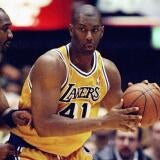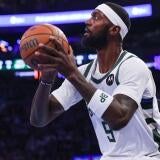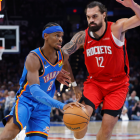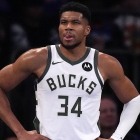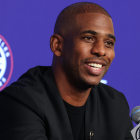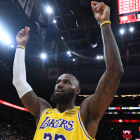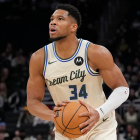Think the NBA offseason was all about superstar duos? These co-stars could keep the 'Big Three' era alive
The third-best players on next year's contenders may not carry superstar names, but the production will likely be similar
Following this summer's unpredictable, mesmerizing, league-shifting NBA free agency period where nine-figure contracts were furiously offered and signed, the true magic number -- for the first time in a long time -- is two. Due to pervasive player movement, there are now more than a handful of teams with two genuine superstars poised to make a run at the Larry O'Brien Trophy, both next season and beyond.
Here's a quick look at the duos that now permeate the NBA:
Newly formed two-superstar combos:
- LeBron James and Anthony Davis, Los Angeles Lakers
- Kawhi Leonard and Paul George, Los Angeles Clippers
- Kevin Durant and Kyrie Irving, Brooklyn Nets
- James Harden and Russell Westbrook, Houston Rockets
Established 1-2 punches:
- Stephen Curry and Klay Thompson, Golden State Warriors
- Joel Embiid and Ben Simmons, Philadelphia 76ers
- Damian Lillard and CJ McCollum, Portland Trail Blazers
- Giannis Antetokounmpo and Khris Middleton, Milwaukee Bucks
Emerging tandems on the rise:
- Nikola Jokic and Jamal Murray, Denver Nuggets
- Kristaps Porzingis and Luka Doncic, Dallas Mavericks
- Kemba Walker and Jayson Tatum, Boston Celtics
It's clear that teams around the league -- largely driven by players' conscious decisions to team up -- are focusing on two All-Star or All-NBA-level stars as the foundational pieces of their franchises. Two being the key number, here.
This is a surprising development given that, for the past decade or so, front offices and players seemed to prefer a triumvirate of superstars -- a "Big Three" as the unit has come to be known -- to give themselves the best chance of winning a title. For teams in a fortunate enough position, the goal was to land three superstars, and the results played out accordingly.
The 2008 Celtics won a title in two Finals appearances behind the trio of Paul Pierce, Kevin Garnett and Ray Allen. The Heat made four straight Finals and won two titles with the infamous South Beach Big Three of LeBron James, Dwyane Wade and Chris Bosh. The Cleveland Cavaliers won their first-ever championship and made three straight trips to the Finals with LeBron, Kyrie Irving and Kevin Love as the nucleus. And then there are the Warriors, who had their own Big Three of Curry, Thompson and Draymond Green before pushing the limits of superstar comprehension by adding Durant to the mix.
All this to say, recent history would dictate that the headlining members of the supremely talented free-agent class of 2019 would have looked to join together as trios, but instead we saw pairs couple off like groomsmen and bridesmaids walking the aisle at a wedding. The Rockets reportedly flirted with the idea of bringing Jimmy Butler to Houston to form a Big Three with Harden and Chris Paul. Instead they ended up swapping their second star (Paul) for a new one (Westbrook), rather than bringing in a third. In Los Angeles, the jaw-dropping combination of LeBron, A.D. and Kawhi was reported as being a "done deal" multiple times before Leonard chose to join the Clippers, with George as his superstar cohort.
As such, the upcoming NBA season has been dubbed the year of the duo, where the Big Three philosophy has been replaced with the Big Two.
Or so it may seem.
Upon further inspection, most of the duos, particularly those that formed this summer, can be more aptly characterized as Big Threes -- if we take our focus away from superstar names, and instead look at production.
Any time three stars have come together in recent history, the production of one of them has inevitably suffered. The two that jump out most are Bosh and Love, who went from averaging 24 and 26 points, respectively, with their former teams, to well under 20 with their "superteams."
In fact, here's a look at the championship-winning teams we've considered to be "Big Threes" over the past decade or so, along with the production from each of the three stars. As you can see, the drop-off between the top two stars and the third star, in many cases, becomes even more exaggerated in the postseason. Since impact isn't solely determined by points per game, we've also included the player's VORP (value over replacement player) as calculated by Basketball Reference.
2007 Spurs
| Player | PPG - Reg. | VORP - Reg. | PPG - Post. | VORP - Post. |
|---|---|---|---|---|
Tim Duncan | 20.0 | 6.3 | 22.2 | 1.7 |
Tony Parker | 18.6 | 3.0 | 20.8 | 0.5 |
Manu Ginobili | 16.5 | 4.8 | 16.7 | 1.3 |
2008 Celtics
| Player | PPG - Reg. | VORP - Reg. | PPG - Post. | VORP - Post. |
|---|---|---|---|---|
Paul Pierce | 19.6 | 4.9 | 19.7 | 1.5 |
Kevin Garnett | 18.8 | 5.5 | 20.4 | 2.1 |
Ray Allen | 17.4 | 3.4 | 15.6 | 1.4 |
2012-13 Heat (average over both seasons)
| Player | PPG - Reg. | VORP - Reg. | PPG - Post. | VORP - Post. |
|---|---|---|---|---|
LeBron James | 27.0 | 8.7 | 28.1 | 3.1 |
Dwyane Wade | 21.7 | 3.5 | 19.4 | 1.2 |
Chris Bosh | 17.3 | 1.5 | 13.1 | 0.6 |
2015 Warriors
| Player | PPG - Reg. | VORP - Reg. | PPG - Post. | VORP - Post. |
|---|---|---|---|---|
Stephen Curry | 23.8 | 7.9 | 28.3 | 2.2 |
Klay Thompson | 21.7 | 2.9 | 18.6 | 0.7 |
Draymond Green | 11.7 | 4.4 | 13.7 | 1.6 |
2016 Cavaliers
| Player | PPG - Reg. | VORP - Reg. | PPG - Post. | VORP - Post. |
|---|---|---|---|---|
LeBron James | 25.3 | 7.6 | 26.3 | 3.1 |
Kyrie Irving | 19.6 | 1.5 | 25.2 | 1.3 |
Kevin Love | 16.0 | 2.8 | 14.7 | 0.6 |
None of these Big Threes had a third star who averaged over 20 points per game. The Warriors title teams of 2017 and 2018 managed to accomplish the feat, with Durant, Curry and Thompson all averaging over 20 in each of those seasons, but the Warriors are clearly the anomaly when it comes to NBA history.
So, in practice, a third "superstar" is generally averaging between 16 and 18 points per game, perhaps fewer in the playoffs.
In contrast, there have only been a few championship teams after the NBA/ABA merger in 1976 led by dominant superstar duos. The 1980s Lakers, known for the tandem of Kareem Abdul-Jabbar and Magic Johnson, received big statistical contributions from players like James Worthy and Byron Scott. Larry Bird and Kevin McHale received plenty of help from Robert Parish and Dennis Johnson in their title runs with the Celtics.
The Michael Jordan-Scottie Pippen Bulls (six titles) and the Shaquille O'Neal-Kobe Bryant Lakers (three titles) are among the first that come to mind when thinking about duos that were truly head-and-shoulders above their teammates, statistically at least. Here's a look at the stats from those two dynasties, plus a few more duo-led championship teams. Note the considerable drop-off between the second and third options.
1991-93 Bulls (average over three seasons)
| Player | PPG - Reg. | VORP - Reg. | PPG - Post. | VORP - Post. |
|---|---|---|---|---|
Michael Jordan | 31.4 | 9.0 | 33.6 | 2.7 |
Scottie Pippen | 19.1 | 6.1 | 20.4 | 1.6 |
Horace Grant | 13.4 | 5.0 | 11.8 | 1.4 |
1995 Rockets
| Player | PPG - Reg. | VORP - Reg. | PPG - Post. | VORP - Post. |
|---|---|---|---|---|
Hakeem Olajuwon | 20.0 | 5.3 | 33.0 | 1.7 |
Clyde Drexler | 18.6 | 2.5 | 20.5 | 1.7 |
Vernon Maxwell | 13.3 | 0.2 | 3.0 (one game) | -0.1 (one game) |
1996-98 Bulls (average over three seasons)
| Player | PPG - Reg. | VORP - Reg. | PPG - Post. | VORP - Post. |
|---|---|---|---|---|
Michael Jordan | 29.6 | 6.8 | 31.4 | 2.0 |
Scottie Pippen | 19.6 | 5.4 | 17.6 | 1.8 |
Toni Kukoc | 13.2 | 3.0 | 10.6 | 0.7 |
2000-02 Lakers (average over three seasons)
| Player | PPG - Reg. | VORP - Reg. | PPG - Post. | VORP - Post. |
|---|---|---|---|---|
Shaquille O'Neal | 27.8 | 5.9 | 28.6 | 1.5 |
Kobe Bryant | 27.9 | 5.5 | 29.4 | 1.1 |
Derek Fisher | 11.1 | 0.9 | 12.1 | 0.7 |
2006 Heat
| Player | PPG - Reg. | VORP - Reg. | PPG - Post. | VORP - Post. |
|---|---|---|---|---|
Dwyane Wade | 27.2 | 7.0 | 28.4 | 2.6 |
Shaquille O'Neal | 20.0 | 2.1 | 18.4 | 0.7 |
Jason Williams | 12.3 | 1.2 | 9.3 | 0.3 |
You can also throw in the second Lakers run with back-to-back titles in 2009-10, as those teams were led primarily by Bryant and Pau Gasol, but you get the point. These are the teams we think about when we think of dominant duos -- two players averaging over 20 points (or close to it) with the next-highest scorer between 11 and 13.
Now, can you look at the teams that formed this offseason and say that they're similar? If anything, the point distribution will likely more closely resemble that of the teams we consider to be "Big Threes" than superstar duos. Let's take it team by team.
Los Angeles Clippers
Superstar duo: Kawhi Leonard, Paul George
Third star: Lou Williams
Winner of back-to-back Sixth Man of the Year awards (and three of the last five), Williams has averaged 21.3 points per game in two seasons with the Clippers. Even with the presence of Leonard and George, it's hard to imagine Williams' scoring dropping very much next season -- especially when considering the inevitable load management that will take place with Leonard and George. Williams might not be a superstar name, but he should easily come close to the production we've seen from the third stars on superteams of old, around 16 to 18 points per game, which makes the Clippers more of a Big Three than a duo.
Los Angeles Lakers
Superstar duo: LeBron James, Anthony Davis
Third star: Kyle Kuzma
Kuzma is a polarizing figure in terms of his NBA ceiling, but you can't argue with the fact that he's produced offensively in his first two seasons, averaging 18.7 points last year. The addition of Davis will likely mean fewer shots, but will also create more space and open looks for Kuzma, who already proved that he can thrive alongside LeBron. Is Kuzma a superstar? Not yet. Can he approximate the third-superstar scoring production that we've seen from the likes of Bosh and Love? Absolutely. The Lakers also have DeMarcus Cousins, who, if he returns to his pre-injury form, could average 16 to 18 points per game for this team.
Brooklyn Nets
Superstar duo: Kevin Durant, Kyrie Irving
Third star: Caris LeVert
The Nets likely won't be serious title contenders next season, with Durant expected to miss the majority, if not all of the year while recovering from Achilles surgery. But that could actually work in their favor, as it will give LeVert another (hopefully full) season to improve and eventually become the third star alongside Irving and K.D. Before suffering a horrific leg injury last November, LeVert averaged 19 points in his first 13 games of the season and looked like a potential All-Star. His absence allowed D'Angelo Russell to take over as the primary scorer, but LeVert returned late in the regular season and played extremely well in the playoffs, averaging 21 points, 4.6 rebounds and 3.0 assists in a first-round loss to the 76ers. By the time Durant returns for the 2020-21 season, LeVert could be a bona fide No. 3 on a potential championship team.
Houston Rockets
Superstar duo: James Harden, Russell Westbrook
Third star: Clint Capela
Still just 25 years old, Capela has blossomed into one of the more reliable big men in the NBA over the past few seasons, and he put up career highs in points (16.6) and rebounds (12.7) last year. He should easily match that production this season, and possibly exceed it given Westbrook's proven track record of stellar pick-and-roll play with Steven Adams in Oklahoma City. Compare Capela to the Rockets' first reported offseason target, Butler, who averaged 18.2 points in 55 games after joining the similarly talent-laden 76ers last season, and you've got a third star who can nearly equal that production in an established role that will also lead to fewer ego clashes and headaches.
So, as we reflect on this summer's free agency, when stars seemingly chose to form duos rather than "Big Threes," we realize that the potential third stars may have already been on the roster -- and maybe that's what made the situations so appealing. Given the economic implications, it has to be incredibly attractive to have an affordable third option who can come close to the production of a big-name "superstar," who would be required to sacrifice his numbers at a much loftier salary.
We'll see how it works out, but whoever ends up winning the 2020 NBA title will likely do it without three traditional stars. That doesn't mean, however, that it will be a two-man show. Many of this year's title favorites will indeed have three stars, but the third will be a slightly more subtle version than what we've seen in the recent past.


